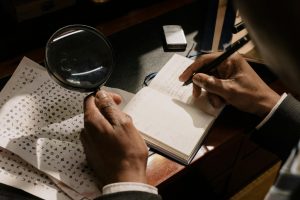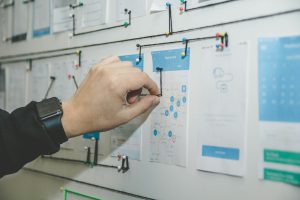5. Reflective Writing for Your Professional Development
Learning Objectives
In this chapter, you will learn how to:
- understand the value and importance of reflective writing in professional contexts
- apply the DIEP (Describe, Interpret, Evaluate, Plan) framework to create meaningful reflective writing pieces
- transform your reflective writing practice into a powerful tool for ongoing professional growth and development.
A Tale of Two Interns
James and Michael started their policy internships at the Department of Infrastructure on the same Monday morning in February. Both were assigned to analyse the impact of remote work on urban planning, a complex project requiring data analysis, stakeholder interviews, and policy recommendations. While their academic backgrounds were similar, their approaches to the internship experience proved markedly different.
From day one, James maintained a detailed reflective journal. Each evening, he spent twenty minutes writing about his experiences, challenges, and insights. He documented his learning process, including his initial confusion about government procedures, breakthroughs in understanding departmental dynamics, and strategies that helped him navigate the organisational culture. When faced with challenges, James used his writing to explore different perspectives and potential solutions, often arriving at innovative approaches through this reflective process.
Michael, however, dove straight into the technical aspects of the project without taking time to process his experiences. While he worked diligently, he found himself increasingly frustrated by bureaucratic processes and overwhelmed by the project’s complexity. His initial confidence gave way to anxiety as he struggled to connect different aspects of the research and translate them into actionable policy recommendations. By the sixth week, he had amassed considerable data but struggled to synthesise it into meaningful conclusions.

Noting the diverging progress, their supervisor asked James to help Michael get the project back on track. James approached this delicately, sharing his own early struggles and the strategies he’d developed. He noticed that while Michael had strong analytical skills, he seemed stuck in the details, unable to see the broader implications of their research. Through their conversations, James began to understand how his reflective practice had helped him maintain perspective and adapt to challenges that had similarly stumped Michael.
In their final week, as they prepared their presentation for the department executives, Michael asked James how he’d managed to maintain such clear direction throughout the project. “Actually,” James replied, “I’ve been keeping a reflective journal. Each day, I write about what I’ve learnt, what’s challenging me, and how it all connects to our project goals. It helps me process the experience and spot patterns I might have missed otherwise. It’s not just about documenting what happened, it’s about making sense of it all.” Michael nodded thoughtfully, realising how this kind of structured reflection might have helped him avoid some of his struggles.
 The internship concluded with a successful presentation, thanks to their combined efforts. While both interns had developed valuable skills, James’s reflective practice had given him additional insights into organisational dynamics, project management, and his own professional growth, insights that would prove invaluable in his future career. Michael left with not just project experience, but also a new appreciation for the role of reflection in professional development.
The internship concluded with a successful presentation, thanks to their combined efforts. While both interns had developed valuable skills, James’s reflective practice had given him additional insights into organisational dynamics, project management, and his own professional growth, insights that would prove invaluable in his future career. Michael left with not just project experience, but also a new appreciation for the role of reflection in professional development.
Why Bother with Reflective Writing?
The story of James and Michael illustrates a pattern that researchers have observed repeatedly in internship settings: the transformative power of reflective writing on professional development. Dr. Reinekke Lengelle’s research provides robust evidence that structured reflective writing during internships significantly enhances employment outcomes. In her 2014 study of bachelor’s students, those who engaged in reflective writing practices received notably higher workplace evaluations from their employers, with 84% of their assessments rated as “excellent” or “very satisfactory” compared to a more distributed range of ratings for non-writing students (Lengelle et al., 2014). Beyond immediate performance metrics, the research revealed that reflective writers developed stronger professional identities and were better equipped to articulate their experiences to future employers. They demonstrated enhanced ‘luck readiness’, the ability to recognise and capitalise on career opportunities, and showed greater career adaptability, a crucial skill in today’s dynamic job market (Lengelle et al., 2016). Perhaps most significantly, these students were more likely to receive offers of continued employment or professional referrals from their internship supervisors, with employers noting their superior ability to integrate feedback and contribute meaningfully to workplace discussions.
Lengelle’s research delves deeply into the mechanisms by which reflective writing enhances skill development during internships. Her studies reveal that students who engage in reflective writing develop what she terms a “double-loop learning” process. They not only acquire technical skills but also develop a sophisticated understanding of how and why they are learning (2014, p. 79). In particular, her 2016 study found that reflective writers showed marked improvement in three crucial areas: cognitive processing, emotional intelligence, and professional adaptability. These students demonstrated superior ability to connect theoretical knowledge with practical application, showing what Lengelle calls “meta positions”, the capacity to step back and analyse their own learning journey (Lengelle et al., 2016, p. 40). For instance, while non-reflective students might simply learn how to complete a task, reflective writers could articulate why certain approaches worked better than others, identify patterns in their learning, and adapt these insights to new situations. The research particularly highlighted how reflective writing helped students develop what employers consistently rate as highly desirable soft skills, including improved communication abilities, better emotional regulation in challenging situations, and enhanced capacity for professional relationship building. This mirrors the experience of James in our story, who developed not only project management skills but also the emotional intelligence to help his struggling peer.
Lengelle’s research demonstrates that:
- Students who engage in reflective writing show significantly higher development of ‘luck readiness’, the ability to recognise and seize career opportunities. (Lengelle et al., 2016).
- Reflective writers demonstrate an enhanced capacity for ‘meta-positions’, the ability to observe and analyse their own learning experiences objectively. (Lengelle et al., 2014).
- Employers rate reflective writing students more positively, with 84% receiving ‘excellent’ or ‘very satisfactory’ evaluations compared to a broader range for non-writers. (Lengelle et al., 2014).
- Students who write reflectively show superior emotional regulation and professional resilience when faced with workplace challenges. (Lengelle et al., 2016).
- Reflective writing enhances students’ ability to connect theoretical knowledge with practical workplace applications, leading to better professional competency development. (Lengelle et al., 2014).
Utilising the DIEP Model of Reflective Writing
While Lengelle’s research provides compelling evidence for maintaining a reflective journal during your internship, you might wonder about the practical process of reflection itself. Many students find themselves unsure where to begin, after all, there’s a significant difference between casually writing about your day and engaging in purposeful professional reflection that enhances your career development.
The DIEP model offers a structured approach to reflection that helps transform your daily experiences into meaningful professional insights. This model, widely used in professional development contexts, breaks down the reflective process into four key components: Describe, Interpret, Evaluate, and Plan. Each component builds upon the previous one, helping you move from simple observation to actionable professional development.
Think of the DIEP model as similar to the scientific method you likely use in your technical work. Just as you wouldn’t jump straight to conclusions in a laboratory experiment without first gathering and analysing data, effective reflection requires a systematic approach to processing your experiences. The DIEP model provides this structure, ensuring you don’t miss crucial insights that could enhance your professional development.
Consider this example: Imagine you’ve just completed your first major presentation to your internship team. Rather than simply noting “That went well” or “I was nervous,” the DIEP model guides you through a deeper analysis:
- Describe: What actually happened during the presentation? What did you do? How did others respond?
- Interpret: Why did things unfold this way? What factors contributed to the outcomes you observed?
- Evaluate: What worked well and what could be improved? How does this experience align with your professional goals?
- Plan: Based on these insights, what specific actions will you take to enhance your presentation skills for next time?
This structured approach transforms a single experience into a valuable learning opportunity that contributes to your professional growth. Students who systematically documented their experiences were significantly more likely to identify and articulate specific skill development in professional contexts (Dunne, 2017). In addition, Dunne (2017) found that structured reflection helped students move from simply describing events to explicitly recognising and naming the professional competencies they were developing, a crucial skill for future job interviews and career advancement. For example, students using a structured approach were more than twice as likely to explicitly name skills like ’emotional intelligence’ or ‘collaborative working’ compared to those who reflected more casually.
The power of structured reflection lies in its ability to bridge the gap between experience and professional development. When students follow a systematic approach to reflection, they develop an enhanced capacity to recognise and name specific professional competencies in their experiences. Rather than simply describing events, they can explicitly connect their experiences to professional skill development, making their learning more concrete and articulate (Dunne, 2017). In the following sections, we’ll explore each component of the DIEP model in detail, providing practical examples and templates to help you implement this evidence-based approach in your own reflective practice.
Describe
In reflective writing, the describe phase focuses on capturing the raw details of your learning experience before diving into deeper analysis. This initial step creates a foundation for meaningful reflection by establishing what occurred and what you learned from it. The key is to identify a specific moment of insight or learning that stands out as significant to your professional development.
When describing your experience, aim to be objective and precise about what happened. Rather than jumping straight to your feelings or interpretations, focus on the concrete details: what was said, what you observed, what you did, or what you read. Include relevant contextual information like when and where the learning occurred, and what specifically triggered your insight. This helps create a clear picture of the learning moment that you can then examine more deeply.
Your description should focus on a single, specific insight rather than trying to cover multiple learning points at once. This insight should represent something new that you’ve learned or realised, a moment where your understanding shifted or deepened. While the insight itself might seem simple, capturing it clearly is essential for the deeper reflection that follows. Think of this step as creating a snapshot of your learning moment that you can then examine from different angles.
 The most effective descriptions strike a balance between being concise and providing sufficient detail. Include enough context that someone else could understand the situation but avoid including irrelevant information that doesn’t contribute to understanding your key insight. Remember that this description serves as the foundation for your subsequent interpretation, analysis, and future planning.
The most effective descriptions strike a balance between being concise and providing sufficient detail. Include enough context that someone else could understand the situation but avoid including irrelevant information that doesn’t contribute to understanding your key insight. Remember that this description serves as the foundation for your subsequent interpretation, analysis, and future planning.
Example
This description clearly identifies the specific insight (the importance of double-checking calculations), provides relevant context (the timing and setting), and explains what triggered the learning (finding an error during a final review). It’s detailed enough to understand the situation but remains focused on the key learning moment.
Activity 5.1: Understanding How to Describe Your Learning Moments
Think of the describe phase as taking a clear photograph of your learning experience. Just like a good photograph captures the important details while keeping the focus sharp, your description should provide the key information about your learning moment without getting blurred by opinions or analysis.
Let’s practice this skill together through a guided activity:
Step 1: Identifying your learning moment
First, reflect on your past week of professional experience. Think about a moment when you learned something new. Perhaps it was a realisation about how things work, a new skill you developed, or an insight into professional practice. Choose one specific moment that stands out.
Step 2: Crafting your description
Now, write a description of this learning moment using these guiding questions:
- What exactly did you learn or realise?
- When and where did this learning occur?
- What was happening when you gained this insight?
- What specifically triggered your learning?
Remember to:
- focus on observable facts rather than feelings or interpretations
- include relevant context but avoid unnecessary details
- keep your description clear and specific
- focus on a single learning moment rather than multiple insights.
Step 3: Self-review
After writing your description, check it against these criteria:
- Could someone else understand what happened based on your description?
- Have you included the what, when, where, and how of your learning?
- Have you avoided including your opinions or analysis of the situation?
- Is your description focused on a single, specific insight?
Here’s a template to help structure your description:
“During [when], while [context], I learned [specific insight]. This learning occurred when [describe the trigger or specific situation]. [Add any other relevant details that help understand the learning moment].”
Looking at your description, highlight any words or phrases that express opinions or analysis. These should be saved for later stages of reflection. Your description should focus purely on what happened and what you learned.
💡Remember
A good description creates a solid foundation for the deeper reflection that follows. Take time to get this step right, as it will make the subsequent stages of reflection more meaningful and insightful.
Interpret
Building on the foundational work done in the describe phase, the interpret section moves your reflection into deeper analytical territory. While description focuses on capturing what happened, interpretation explores what it means, transforming your raw observations into meaningful insights about your learning and development.
When interpreting your experience, you’ll examine your described insight from multiple angles, considering its broader implications and connections. This is where you begin to unpack why this learning moment matters, how it relates to your existing knowledge, and what questions it raises for your future practice. Rather than simply stating what you learned, you’ll analyse how this new understanding might influence your thinking and actions going forward.
Think of interpretation as being like a detective examining evidence. Just as a detective looks beyond surface-level observations to understand the deeper story, your interpretation should look beyond the immediate details of your learning experience to understand its significance. What might this insight reveal about your professional development? How does it connect to theories or concepts from your coursework? What assumptions or previous understandings might it challenge? These questions help transform your description from a simple account of what happened into a meaningful exploration of your learning journey.

The key to effective interpretation is making connections between your insight and your previous knowledge, between theory and practice, between your immediate experience and broader professional contexts. While description asks “What happened?”, interpretation asks “What does this mean for my learning and development?” This deeper analysis sets the stage for the evaluation and planning that will follow in subsequent stages of your reflection.
In reflective writing, the interpret section moves beyond describing what happened to explore the deeper meaning and significance of your insight. Rather than simply restating events, you examine why your learning experience matters and how it connects to your broader professional development.
Consider how an engineering student might interpret their insight about double-checking calculations:
Example
This experience with unit conversion errors has revealed important truths about engineering practice that go far beyond simple calculation checking. While the immediate lesson about verifying work is valuable, the deeper significance lies in understanding how routine tasks can have serious real-world impacts. In environmental engineering, even a small calculation error could lead to incorrect water quality recommendations, potentially affecting community health. This realisation transforms what might seem like basic double-checking into an essential professional responsibility.
The timing of this insight, during my third week of internship, is particularly meaningful. As I was beginning to feel more confident in my role, this experience served as a crucial reminder that expertise isn’t about never making mistakes. It’s about developing systematic approaches to prevent errors from affecting outcomes. This understanding connects directly to what we learned in Professional Practice about engineering ethics and public safety responsibilities. The experience has also sparked important questions about how to develop robust quality control habits early in my career, especially when dealing with time pressures and competing deadlines.
Perhaps most significantly, this experience has highlighted how professional judgment develops. That internal prompt to pause and review the calculations, despite my initial confidence, represents an emerging sense of professional intuition. It suggests I’m beginning to develop the kind of reflective practice that experienced engineers rely on to maintain high standards of work.
Notice how this interpretation examines the broader implications of the experience, makes connections to professional practice and learning, and considers how this insight might influence future behaviour.
Activity 5.2: Moving from Description to Deeper Understanding
Let’s practice developing your interpretation skills through a guided activity that builds on your description of a learning moment.
Step 1: Starting with your description
Take the description you wrote in our previous activity or use this example:
During my third week of internship at the environmental engineering firm, I learned the importance of double-checking all calculations, even for seemingly simple tasks. This insight came while I was working on a routine water quality analysis report. I had completed the chemical concentration calculations, which I had done many times before, and was about to send them to my supervisor. However, something made me pause and review the numbers one more time. During this review, I discovered I had made a small error in unit conversion that would have significantly affected the final recommendations. Thanks to this final check, I was able to correct the error before submitting the report.
Step 2: Exploring deeper meaning
Take your description and answer these guiding questions. Write at least two sentences for each.
Why does this insight matter?
- Think about:
- How might this learning affect your future practice?
- What broader principles does this insight reveal?
- What might have happened if you hadn’t gained this insight?
- What connections can you make?
- Consider how this links to:
- your previous knowledge or experiences
- theories or concepts from your studies
- professional standards or practices
- broader industry implications
- What questions does this raise?
- Reflect on:
- What else do you need to learn?
- What assumptions has this challenged?
- What might you do differently in the future?
- What broader issues does this highlight?
Step 3: Crafting your interpretation
Now, combine your answers into a coherent paragraph that explores the meaning of your insight. Start with a sentence that connects to your description, then weave together your responses about significance, connections, and questions.
Step 4: Self-review
Check your interpretation against these criteria:
- Have you moved beyond describing what happened to explain why it matters?
- Have you made meaningful connections to your learning or professional practice?
- Have you identified questions or implications for future practice?
- Does your interpretation demonstrate deeper thinking about the experience?
Step 5: Peer discussion
Find a classmate and share your interpretations. Discuss:
- What aspects of each other’s interpretations seem particularly insightful?
- What additional perspectives could be considered?
- How might these insights apply in different professional contexts?
💡Remember
Effective interpretation transforms a simple observation into meaningful professional learning by examining its broader significance and implications. Your goal is to demonstrate how this insight contributes to your developing professional understanding.
Evaluate
While interpretation helps us understand the meaning of our insights, evaluation takes our reflection further by assessing the value of what we’ve learned. This phase asks us to make thoughtful judgments about how our learning experiences contribute to our professional development and future practice. When evaluating your insights, you examine not just what you learned and what it means, but how this learning will benefit you going forward. This might include assessing how your new understanding will change your approach to professional tasks, enhance your confidence in certain areas, or influence your future decision-making.
Effective evaluation requires examining your learning experience from multiple angles. Beyond simply stating that something was useful, you need to articulate specifically how and why this learning matters for your professional development. You might consider how your new understanding changes your capabilities, influences your professional confidence, or shapes your approach to future challenges. For instance, you could assess how a new insight affects your technical skills, your professional judgment, or your ability to work with others.

Making connections to your broader professional or academic context strengthens your evaluation. Consider how your learning aligns with professional standards, industry best practices, or theoretical frameworks from your studies. This might involve examining how your new understanding supports or challenges existing theories, or how it contributes to your developing professional identity. By grounding your evaluation in these broader contexts, you demonstrate a deeper understanding of your learning’s significance within your field.
When evaluating your learning, it’s important to be specific about future applications. Rather than making general statements about usefulness, describe concrete ways you plan to apply your new understanding. Think about how this learning might influence your decision-making, change your work practices, or enhance your professional relationships. Consider also any limitations or conditions that might affect how you apply this learning, being realistic about both the benefits and potential challenges of implementing your new understanding demonstrates mature professional judgment.
Let’s examine how to evaluate the learning experience of double-checking calculations.
Example
This experience with catching a unit conversion error has proven invaluable for my development as an environmental engineer. While it might seem like a simple lesson about checking calculations, understanding its importance has fundamentally changed how I approach all technical work. Previously, I viewed double-checking as a time-consuming extra step that demonstrated a lack of confidence. Now, I recognise it as an essential professional practice that reflects a mature understanding of engineering responsibility. This shift in perspective has already improved my work quality and professional confidence.
The most significant value of this learning lies in how it has transformed my understanding of professional judgment. I now appreciate that engineering expertise isn’t just about being able to perform calculations correctly. It’s about developing systematic approaches to ensure accuracy and safety. This realisation has changed how I structure my work time, deliberately building in review periods rather than rushing to complete tasks. In team projects, I’ve started advocating for peer review processes, which has not only improved our collective work quality but has also helped me develop valuable leadership skills.
Looking ahead, I can see how this understanding will benefit my future practice in several ways. First, it provides a foundation for developing more robust quality control processes in my work. Second, it has enhanced my ability to mentor others by helping me articulate why certain professional practices matter. Perhaps most importantly, it has given me a deeper appreciation for how seemingly small decisions in engineering work can have significant real-world impacts. This awareness will guide my professional decision-making throughout my career, helping me maintain the high standards that environmental engineering demands.
Notice how this evaluation:
- makes specific judgments about the learning’s value
- describes concrete changes in professional practice
- connects the learning to broader professional development
- looks forward to future applications
- demonstrates growth in professional understanding.
Activity 5.3: Developing Your Evaluation Skills
This activity helps you move beyond describing and interpreting your learning to making thoughtful judgments about its value for your professional development. Through guided practice, you’ll learn to evaluate how your insights contribute to your growth as a professional.
Part 1: Examining value
Take the learning experience you’ve been working with (or use our engineering calculation example) and answer these questions in detail.
Think about the immediate value of your learning:
- How has this insight already changed how you work or think?
- What specific improvements have you noticed in your practice?
- How has it affected your professional confidence?
Consider the broader professional value:
- How does this learning align with professional standards in your field?
- What aspects of professional practice does it help you understand better?
- How might it influence your interactions with colleagues or clients?
Part 2: Looking forward
Write two paragraphs exploring future applications.
First paragraph: Focus on specific ways you plan to apply this learning in your future practice
- What processes or approaches will you modify?
- How will you incorporate this understanding into your daily work?
- What specific situations will benefit from this new knowledge?
Second paragraph: Consider broader professional implications
- How might this learning influence your long-term career development?
- What additional skills or knowledge might you need to develop?
- How could this understanding help you contribute to your field?
Part 3: Testing your evaluation
Review your writing by asking:
- Have you moved beyond just saying something was “useful” to explaining specifically how and why?
- Have you identified concrete changes in your practice or thinking?
- Have you considered both immediate and long-term benefits?
- Have you demonstrated how this learning contributes to your professional development?
Part 4: Peer discussion
Find a partner and take turns sharing your evaluations. For each other’s work, discuss:
- What specific benefits or applications did your partner identify that you hadn’t considered?
- How might their learning be valuable in different professional contexts?
- What additional opportunities for applying this learning can you suggest?
- How does their evaluation demonstrate professional growth?
💡Remember
Strong evaluation demonstrates mature professional judgment by examining both the immediate and long-term value of your learning. Your goal is to show how this understanding contributes to your development as a professional in your field.
Plan
After evaluating the value and impact of our learning experiences, the natural next step is to consider how we can deliberately apply these insights in our future practice. While evaluation helps us understand how our learning has changed us, planning transforms these reflections into concrete actions that will shape our professional development. This forward-looking phase moves us from understanding the significance of what we’ve learned to map out specific ways to implement and build upon these insights, ensuring our reflective learning translates into tangible professional growth.
The planning phase bridges the gap between reflection and action, helping us identify specific opportunities to apply our learning and areas where we need to develop further. By thoughtfully considering how we’ll use our insights in future situations, we transform our reflective learning from a passive understanding into an active guide for professional development.

When writing the planning section of your reflection, begin by identifying specific contexts where your insights could be valuable. These typically fall into three main categories: your current academic program, your future professional practice, and your broader personal development. Consider how your learning might be relevant in each of these areas, being as specific as possible about potential applications.
For example, rather than simply stating “I will use these communication skills in my future career,” you might write: “Understanding the importance of clear documentation will be particularly valuable when I begin my engineering career, especially in project handovers and team collaborations. I plan to develop templates for different types of technical documentation to ensure consistent and thorough information sharing.”
Time frames are crucial in planning. Consider both immediate applications within your current studies and longer-term implementations in your future career. You might discuss how you’ll apply your learning in upcoming assignments or group projects, as well as how these skills will transfer to professional situations you expect to encounter after graduation
It’s also important to identify any additional learning or development needed to fully implement your insights. This might include recognising gaps in your knowledge or skills that need to be addressed. For instance, you might write: “To build on my understanding of sustainable design principles, I will need to familiarise myself with current environmental regulations and certification requirements. I plan to complete online modules in environmental compliance during the semester break.”
When writing your plan, use future tense to emphasise the forward-looking nature of this section. Begin sentences with phrases like “I will…” or “This learning will be applied…” to clearly indicate your intended actions. Be specific about how you will implement your insights, including concrete steps or strategies you plan to use
Remember to connect your plans back to your professional context. Consider how your intended actions align with industry expectations and professional standards in your field. This helps demonstrate that your reflective learning is grounded in practical, professional applications rather than remaining purely theoretical.
Finally, consider potential challenges or obstacles you might face in implementing your plans, and outline strategies to address these. This shows that you’ve thought critically about the feasibility of your plans and are prepared to overcome potential difficulties.
Example
This experience with calculation verification will be particularly valuable as I progress through my environmental engineering degree and into my professional career. In my remaining coursework, I will implement a structured verification process for all technical assignments, setting aside a specific portion of time (at least 15% of the total allocated time) for thorough review. This approach will help embed good practices before I take on professional responsibilities where the stakes are much higher.
When I begin my career as an environmental engineer, I will develop a comprehensive quality control checklist for different types of calculations and analyses. This checklist will include common conversion factors, typical value ranges for various parameters, and key verification steps. I plan to share this resource with my future teams, contributing to a culture of rigorous verification while helping junior engineers avoid similar mistakes.
To further strengthen this practice, I will seek out opportunities to learn about quality control systems used in environmental engineering firms. During my remaining internship time, I plan to discuss this topic with senior engineers, understanding how they’ve developed their verification processes over their careers. This knowledge will help me build more robust professional practices early in my career.
In the broader context of professional development, I will use this insight to develop a more comprehensive approach to risk management in engineering work. This includes not only calculation verification but also understanding how different components of environmental analysis interconnect and influence final recommendations. I plan to maintain a log of near-miss incidents (like this unit conversion catch) to help identify patterns and develop more effective preventive measures.
Beyond my individual practice, I anticipate using this experience when I eventually mentor junior engineers or interns. I will share not just the technical lesson about double-checking calculations, but also the deeper understanding about professional responsibility and the development of engineering judgment. This will help create a positive cycle of learning and improvement within the profession.
By following these guidelines, your planning section will effectively bridge the gap between reflection and action, creating a clear roadmap for applying your learning in meaningful ways. This approach ensures that your reflective practice contributes directly to your professional development and growth.
Activity 5.4: Developing Professional Plans Through Research-Informed Reflection
This activity helps you transform personal insights into professional development plans by connecting your experiences with industry standards and professional expectations. Through research and reflection, you’ll create a detailed plan that aligns your learning with professional practice.
Part 1: Starting with experience
Begin with your descriptive reflection about a significant learning moment from your placement. You can use your own reflection or this example:
During my third week of internship at the environmental engineering firm, I learned the importance of double-checking all calculations, even for seemingly simple tasks. This insight came while I was working on a routine water quality analysis report. I had completed the chemical concentration calculations, which I had done many times before, and was about to send them to my supervisor. However, something made me pause and review the numbers one more time. During this review, I discovered I had made a small error in unit conversion that would have significantly affected the final recommendations. Thanks to this final check, I was able to correct the error before submitting the report.
Part 2: Professional context research
Before developing your plan, research the professional context of your insight:
- Professional Association Standards
- Identify the key professional associations in your field (e.g., Engineers Australia, Australian Institute of Environmental Engineers).
- Review their professional practice standards and guidelines.
- Find specific standards or guidelines related to your insight (e.g., quality control processes, verification procedures, ethics or code of conduct).
- Document how your insight connects to these professional standards.
- Industry Best Practices
- Research current best practices in your field related to your insight.
- Find at least two peer-reviewed articles or industry publications discussing these practices.
- Identify any emerging trends or developments in this area.
- Note how these practices might influence your future professional development.
Part 3: Development planning
Using your research and reflection, identify professional development related to your experience. Highlight:
- Immediate Applications (Current Studies)
- How will you apply this learning in your remaining coursework?
- What specific assignments or projects could benefit from this insight?
- What additional skills do you need to develop?
- Early Career Implementation
- How will you apply this learning in your first professional role?
- What systems or processes will you develop?
- How does this align with professional standards you’ve researched?
- Long-term Professional Growth
- How might this insight influence your career trajectory?
- What ongoing professional development will you need?
- How will you contribute to your profession’s development in this area?
Part 4: Writing your plan reflection
Using your research and reflections, write a detailed plan section that connects your personal insight to professional standards while outlining specific implementation strategies. Your plan reflection should move from immediate applications through to long-term professional development.
Begin by identifying specific contexts where you’ll apply this learning, referencing the professional standards and best practices you’ve researched. For example:
The importance of systematic calculation verification, as emphasised in Engineers Australia’s Standard 3.2, will inform both my remaining studies and future engineering practice. In my final year of coursework, I will implement a structured verification process aligned with industry best practices, allocating specific time for peer review and documentation. This approach aligns with the Australian Institute of Environmental Engineers’ guidelines on quality control in environmental assessments.
Then, describe specific strategies for implementing your learning, connecting these to your research findings. For example:
Drawing on current industry practices identified in the Journal of Environmental Engineering, I will develop a comprehensive verification checklist incorporating both technical accuracy and contextual reasonableness checks. This system will evolve through my early career as I gain experience with different types of environmental assessments and their specific requirements.
Consider your longer-term professional development needs, using your research to identify areas for growth:
To further develop my professional capabilities in this area, I plan to pursue specialised training in quality management systems, particularly focusing on environmental monitoring and assessment. The Environmental Institute of Australia and New Zealand offers professional development courses in this area, which will help me build on my current understanding while staying current with evolving industry standards.
End by connecting your plans back to broader professional responsibility:
By implementing these structured approaches to verification and continuing to develop my professional practices, I will contribute to maintaining the high standards our profession demands while helping to mentor future environmental engineers in developing similar rigorous approaches.
Remember to:
- reference specific professional standards and guidelines you’ve researched
- connect your personal learning to industry best practices
- outline concrete implementation steps
- consider both immediate and long-term applications
- show how your plans align with professional expectations
- use future tense to emphasise planned actions
- maintain a professional tone while showing personal commitment to growth.
Your plan reflection should demonstrate thoughtful consideration of how your learning experience connects to professional practice while providing clear pathways for implementation and development.
Maintaining Reflective Practice
Developing a consistent reflective practice during your internship helps build professional insight and document your growth. Think of these weekly reflections as creating a professional learning journal that you can draw upon throughout your career. Here’s how to make the most of this practice:

💡Remember
Reflective writing is itself a skill that develops over time. Your early reflections might feel basic or uncertain. This is completely normal. As you progress through your internship, you’ll likely find your reflections becoming more nuanced and insightful. What matters most is maintaining the practice consistently and pushing yourself to think deeply about your learning each week.
By maintaining thoughtful weekly reflections, you’re not just documenting your internship experience, you’re actively shaping your professional development and creating a valuable resource for your future career. Each reflection builds upon previous insights, helping you develop the kind of thoughtful, reflective practice that characterises successful professionals in your field.
Key Takeaways
In this chapter, we covered:
- how structured reflective writing enhances professional development during internships, helping transform daily experiences into meaningful insights that contribute to career growth and learning
- the systematic application of the DIEP (Describe, Interpret, Evaluate, Plan) framework to create detailed, purposeful reflections that demonstrate professional growth and understanding
- methods for crafting precise descriptions of learning experiences that provide clear foundations for deeper analysis, focusing on specific moments that reveal important professional insights
- techniques for interpreting experiences by examining their broader significance, making connections to professional standards and theoretical knowledge, and identifying questions for future learning
- strategies for evaluating learning experiences by assessing their immediate and long-term value for professional development, including specific ways they enhance technical and interpersonal capabilities
- approaches for developing concrete, actionable plans that connect personal insights to professional standards while creating clear pathways for implementing learning in both immediate and future practice.
References
Dunne, J. (2017). Work placement reflective assessments and employability enhanced through highlighting graduate attributes. Journal of Teaching and Learning for Graduate Employability, 8(1), 40–59. https://doi.org/10.21153/jtlge2017vol8no1art616
Lengelle, R., Meijers, F., Poell, R., Geijsel, F., & Post, M. (2016). Career writing as a dialogue about work experience: A recipe for luck readiness? International Journal for Educational and Vocational Guidance, 16, 29–43. https://doi.org/10.1007/s10775-014-9283-1
Lengelle, R., Meijers, F., Poell, R., & Post, M. (2014). Career writing: Creative, expressive and reflective approaches to narrative identity formation in students in higher education. Journal of Vocational Behavior, 85(1), 75–84. https://doi.org/10.1016/j.jvb.2014.05.001
Media Attributions
- Man in Black Dress Shirt © Mikhail Nilov, available under a Pexels licence
- Person Writing on Notebook © Tima Miroshnichenko, available under a Pexels licence
- Woman Using a Calculator While Sitting In Front of a Laptop © Mikhail Nilov, available under a Pexels licence
- Photo of Person Taking Down Notes © cottonbro studio, available under a Pexels licence
- Man Wearing Orange Hard Hat © Kateryna Babaieva, available under a Pexels licence
- Person working on blue and white paper on board © Alvaro Reyes, available under an Unsplash licence
- Unknown person writing © Marcos Paulo Prado, available under an Unsplash licence

